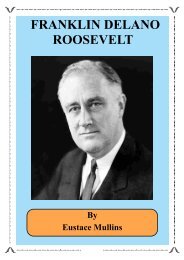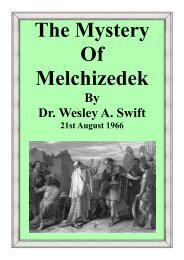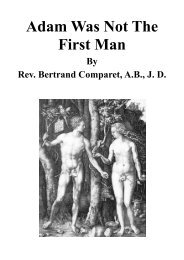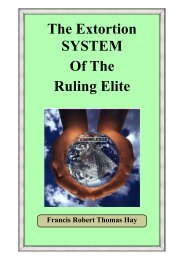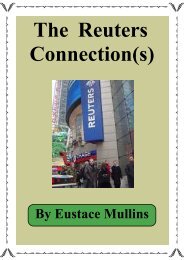Curse of Cannan - The New Ensign
Curse of Cannan - The New Ensign
Curse of Cannan - The New Ensign
Create successful ePaper yourself
Turn your PDF publications into a flip-book with our unique Google optimized e-Paper software.
He later had two children by his mistress. <strong>The</strong>y took the family name <strong>of</strong> Este. Queen Victoria<br />
was always proud <strong>of</strong> her connection with the House <strong>of</strong> Este, which had begun as the House <strong>of</strong><br />
Azoll.<br />
<strong>The</strong> House <strong>of</strong> Windsor is the world's preeminent family <strong>of</strong> reigning monarchs today. <strong>The</strong>y<br />
represent the final triumph <strong>of</strong> the Guelph faction, or black nobility, the culmination <strong>of</strong> the<br />
Canaanite drive for power. <strong>The</strong>ir rise had been continuous since the 13th century, when they<br />
defeated their most powerful opponents, the Teutonic Hohenstaufen dynasty, who were known<br />
as the Ghibelline faction. <strong>The</strong>y had been named after one <strong>of</strong> the Hohenstaufen strongholds,<br />
Weiblingen. Frederick I, Barbarossa, as head <strong>of</strong> the Hohenstaufens, had extended his rule into<br />
northern Italy, where he was surprised by the unexpectedly strong challenge from the Guelph<br />
faction. <strong>The</strong> struggle, which lasted for more than a century, was won by the lower nobility faction<br />
<strong>of</strong> the Guelphs because <strong>of</strong> their strength among the rising merchant class; the Ghibellines, or<br />
high nobility, continued to be the knights on horseback, refusing to sully their hands with trade.<br />
<strong>The</strong> Ghibellines ruled the northern cities <strong>of</strong> Siena, Milano, and Pisa, while the strength <strong>of</strong> the<br />
Guelphs was centered in Florence and Farrara. Otto IV <strong>of</strong> Guelph carried on the fight against<br />
Philip <strong>of</strong> Swabia, a Hohenstaufen, but the Hohenstaufens found themselves outnumbered by the<br />
forces <strong>of</strong> the League <strong>of</strong> Rhenish Towns, a merchant alliance which was able to raise large sums<br />
to outfit the condottieri. By the end <strong>of</strong> the fifteenth century, the Guelphs had triumphed.<br />
Alfonso I <strong>of</strong> Este married Lucrezia Borgia. His sister, Mary <strong>of</strong> Modena, married James II <strong>of</strong><br />
England, bringing the Este line into the English ruling family.<br />
<strong>The</strong> Ghibellines favored a strong central rule and imperial power, while the Guelphs agitated for<br />
decentralized power and the "Rights <strong>of</strong> Man," a motto which later became their rallying cry for<br />
their drive to power.<br />
In the twentieth century, the surviving heirs <strong>of</strong> the Guelph and Ghibelline factions were arrayed<br />
against each other in two world wars. Germany had become a world power through the military<br />
instincts and drive <strong>of</strong> the Prussian Ghibellines. In 1866, Bismarck, to further his goal <strong>of</strong> unifying<br />
Germany, had dispossessed a number <strong>of</strong> German princes from their estates. <strong>The</strong> Duke <strong>of</strong> Nassau<br />
and the Elector <strong>of</strong> Hesse formally renounced their claims; only the princes <strong>of</strong> Hanover, who were<br />
the heirs to the throne <strong>of</strong> Brunswick, refused to relinquish their holdings. For decades afterwards,<br />
the Hanovers considered themselves to be at war with Prussia. Indeed, two world wars did take<br />
place, due in part to the continued resentment <strong>of</strong> the ruling family <strong>of</strong> England against the rules<br />
<strong>of</strong> Germany. It is an interesting point that the victorius Hanovers saw to it that a defeated Germany<br />
was split into two, small, militarily occupied countries after World War II, the final revenge <strong>of</strong><br />
the victors.<br />
Calvinism, a strong influence in England during the sixteenth century, capitalized on the growing<br />
power <strong>of</strong> the mercantile fleet and the black nobility, whose main interest was money. Unlike<br />
previous religious institutions, which had placed great emphasis on austerity and vows <strong>of</strong> poverty,<br />
this new religious doctrine stressed that the charging <strong>of</strong> interest in loans and the amassing <strong>of</strong><br />
wealth was the new way <strong>of</strong> doing the work <strong>of</strong> the Lord. It was a welcome revelation to the<br />
growing merchant class that God really wanted us to become wealthy. "Enricchez vous!" became<br />
the new battle cry which swept across Europe as the Canaanites built great commercial empires.<br />
<strong>The</strong> prophet <strong>of</strong> this new divine revelation was one Jean Cauin <strong>of</strong> Noyons, France. He was<br />
educated It the College du Montagu, where Loyola, founder <strong>of</strong> the Jesuit sect, had studied. Cauin<br />
later moved to Paris, where he continued his studies with the Humanists from 1531-32. During<br />
his stay in Paris, he was known as Cauin. He then moved to Geneva, where he formulated the<br />
philosophy now known as Calvinism. At first known in Geneva as Cohen (the usual pronunciation<br />
<strong>of</strong> Cauin), he Anglicized his name to John Calvin. This religious movement was based on a literal<br />
Jewish interpretation <strong>of</strong> the Ten Commandments, Old Testament philosophy, and the prohibition<br />
<strong>of</strong> graven images. <strong>The</strong> early disciples <strong>of</strong> Calvinism were known as "Christian Hebraists." <strong>The</strong><br />
advent <strong>of</strong> Calvinism made possible the great expansion <strong>of</strong> Jews into further avenues <strong>of</strong> European<br />
( Page 42)



